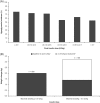When basal insulin is not enough: A dose-response relationship between insulin glargine 100 units/mL and glycaemic control
- PMID: 30724009
- PMCID: PMC6594069
- DOI: 10.1111/dom.13653
When basal insulin is not enough: A dose-response relationship between insulin glargine 100 units/mL and glycaemic control
Abstract
Aims: A post-hoc analysis to assess the impact in people with type 2 diabetes, of increasing doses of basal insulin on glycaemic measures, body weight and hypoglycaemia.
Research design and methods: We included data from prospective, randomized controlled treat-to-target trials of ≥24 weeks' duration in people with type 2 diabetes, uncontrolled on metformin and sulphonylureas, and treated with insulin glargine 100 units/mL (U100), who had at least six fasting plasma glucose (FPG) measurements. The impact of insulin dose on glycated haemoglobin (HbA1c) values, FPG, hypoglycaemia incidence (<3.9 mmol/L [70 mg/dL]), and body weight was analysed. A total of 458 participants from three eligible trials were included.
Results: The observed relationship between higher basal insulin doses and glycaemic control was non-linear, with increasing insulin dose leading to smaller reductions in FPG and HbA1c for doses >0.3 IU/kg/d, with a plateauing effect at 0.5 IU/kg/d. Total daily dose of insulin >0.5 IU/kg/d resulted in greater weight gain, but without higher rates of hypoglycaemia, compared with insulin doses ≤0.5 IU/kg/d.
Conclusions: This analysis indicates that basal insulin doses >0.5 IU/kg/d have diminishing additional impact on improving glycaemic measures, with the disadvantage of additional weight gain. Clinicians should consider anti-hyperglycaemic treatment intensification at doses approaching 0.5 IU/kg/d.
Keywords: HbA1c; basal insulin; glargine; postprandial; type 2 diabetes.
© 2019 The Authors. Diabetes, Obesity and Metabolism published by John Wiley & Sons Ltd.
Conflict of interest statement
Author contributions
G.E.U., N.S., T.D., L.T., J.C. and C.S. participated in the preparation of the manuscript, data review, and presentation. G.E.U. had full access to all the data in the study and takes responsibility for the integrity of the data and the accuracy of the data analysis.
Figures



Comment in
-
Response to Umpierrez et al.Diabetes Obes Metab. 2019 Oct;21(10):2344-2345. doi: 10.1111/dom.13815. Epub 2019 Jul 10. Diabetes Obes Metab. 2019. PMID: 31210017 No abstract available.
-
When basal insulin is not enough: response to M Davidson.Diabetes Obes Metab. 2020 Apr;22(4):711-712. doi: 10.1111/dom.13916. Epub 2019 Dec 5. Diabetes Obes Metab. 2020. PMID: 31724245 No abstract available.
References
-
- CDC . National Diabetes Statistics Report, 2017. Available at https://www.cdc.gov/diabetes/pdfs/data/statistics/national-diabetes-stat.... Accessed September 3, 2018.
-
- ADA . Pharmacologic approaches to glycemic treatment.Diabetes Care. 2018;41(suppl 1):S73‐S85. - PubMed
Publication types
MeSH terms
Substances
Grants and funding
LinkOut - more resources
Full Text Sources
Medical

